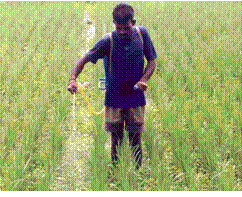| Particulars of Rice Varieies | Seasons and Varieties | Seedling Throwing Method |
| System of Rice Indencification | Transplanted Hybrid Rice | Transplanted Puddled Lowland Rice | Wet Seeded Puddled Lowland Rice |
DRY SEEDED RAINFED UN-PUDDLED LOWLAND RICE
RAINFED RICE
The crop establishment, growth and maturity depend up on the rainfall received. There will be standing water after crop establishment for a minimum period of few days to a maximum up to grain filling, depending up on the rainfall. This type of cultivation in Tamil Nadu is called as ‘rainfed rice’, with the assumption that the soil moisture will be under unsaturated (dry) condition during establishment or entire growth period, with reference to tropical climate.
Area
- Coastal districts of Tamil Nadu like Kanchipuram, Tiruvallur, Pudukottai, Ramanathapuram, Virudhunagar, Sivagangai and Kanyakumari.
Season
- June – July – (Coastal northern districts)
- September – October (Coastal southern districts)
Field preparation
- Dry plough to get fine tilth taking advantage of rains and soil moisture availability.
- Apply gypsum at 1 t/ha basally wherever soil crusting and soil hardening problem exist.
- Perfect land leveling for efficient weed and water management.
- Provide shallow trenches (15 cm width) at an interval of 3m all along the field to facilitate draining excess water at the early growth stage.
Varieties
- Short duration varieties as mentioned in season and varieties including local land races suitable for those tracts.
Sowing
- Seed rate: 75kg/ha dry seed for any recommended variety.
- Seed hardening with 1% KCl for 16 hours (seed and KCl solution 1:1) and shade dried to bring to storable moisture. This will enable the crop to withstand early moisture stress.
- On the day of sowing, treat the hardened seeds first with Pseudomonas fluorescens 10g/kg of seed and then with Azophos 2000g or Azospirillum and Phosphobacteria @ 600g each per ha seed, whichever is available.
- Drill sow with 20 cm inter row spacing using seed drill.
- The seeds can also be sown behind the country plough
- Depth of sowing should be 3 - 5 cm and the top soil can be made compact with leveling board.
- Pre-monsoon sowing is advocated for uniform germination.
After cultivation
- Azospirillum inoculants 10 packets (2000g/ha) and Phosphobacteria 10 packets (2000g/ha) or 20 packets (4000g/ha) of Azophos mixed with 25 kg of FYM may be broadcasted uniformly over the field just after the receipt soaking rain / moisture.
- Thinning and gap filling should be done 14 - 21days after sowing, taking advantage of the immediate rain
- Spray Cycocel 1000 ppm (1 ml of commercial product in one lit. of water) under water deficit situations to mitigate ill-effects.
- Foliar spray of Kaolin 3% or KCl 1% to overcome moisture stress at different physiological stages of rice.
Manures and fertilizer application
- Blanket recommendation : 50:25:25 kg N:P2O5:K2O /ha
- Apply a basal dose of 750 kg of FYM enriched with fertilizer phosphorus (P at 25 kg/ha)
- Apply N and K in two equal splits at 20 - 25 and 40 - 45 days after germination.
- If the moisture availability from the tillering phase is substantial, three splits (25 kg N and 12.5 kg K at 20-25, 40-45 and 60-65 DAG) can be adopted.
- N at PI may be enhanced to 40 kg, if the tiller production is high (may be when the estimated LAI is greater than 5.0) and moisture availability ensured by standing water for 10 days.
- Basal application of FeSO4 at 50 kg/ha is desirable for iron deficient soil.
- Foliar spray of 1% urea + 2% DAP + 1%KCl at PI and 10 days later may be taken up for enhancing the rice yield if sufficient soil moisture is ensured
Weed management
- First weeding can be done between 15 and 21 days after germination.
- Second weeding may be done 30 - 45 days after first weeding.
- Apply pendimethalin 1.0kg/ha on 5 days after sowing or Pretilachlor + safener (Sofit) 0.45kg/ha on the day of receipt of soaking rain followed by one hand weeding on 30 to 35 days after sowing.

Application of post emergence herbicide
(Pretilachlor + safener (Sofit) 0.45kg/ha)

Harvesting
Same as that for wet rice cultivation